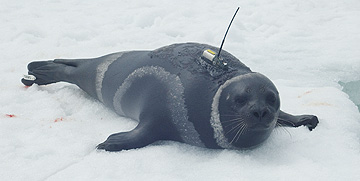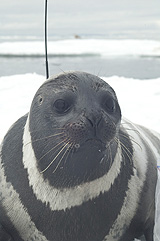Polar Ecosystems Program
Habitat Use and Seasonal Movements of Ribbon Seals in the Bering Sea and North Pacific

Figure 3. An adult male ribbon seal live-captured off the coast of eastern Kamchatka, Russia, and
instrumented with a satellite-linked dive recorder. Photo by Michael Cameron. |
 |
In June 2005, researchers from the Polar Ecosystem
Program (PEP) successfully live-captured 10 ribbon seals (Histriophoca fasciata)
off the coast of eastern Kamchatka, Russia. The seals were captured in hoop nets
on the ice floes where they were resting and were physically restrained and
instrumented with satellite-linked dive recorders (SDRs) (Fig 3.). The
SDRs provide data on a sealís location and on the timing and depths of
its dives. The data, received through the Argos data collections system,
can be analyzed to provide: 1) correction factors for seals missed (i.e., not hauled
out) during sightings surveys, 2) information on habitat selection (i.e., foraging
and haul-out locations) and seasonal movements (i.e., post-molt
migration routes), and 3) information on sealsí foraging behavior.
Ribbon seals are an important subsistence resource
for some Alaska Native communities and are likely to be a key ecological
component of arctic marine ecosystems, yet relatively little is known of
their abundance, seasonal distribution, migration, and food habits. The
distributions and densities of ice-dwelling seals are highly sensitive
to suitable sea ice conditions and, as such, may be particularly
vulnerable to climatic change. Changes in sea ice extent have been
nonuniform; therefore, the effects on seals are likely to occur on
regional scales, emphasizing the need for quality data throughout their
range. Some researchers have speculated that most ribbon seals remain in
the Bering Sea and become pelagic during the summer, unlike ringed seals
(Phoca hispida) that follow the ice edge north as it melts. If
true, the impact that ribbon seals may have on the Bering Seaís
invertebrate and fish stocks could be significant.
Preliminary results indicate that these "pagophilic seals"
may, after the molt, remain primarily in the ice-free areas south of the
Bering Strait. Most seals dispersed southeast into ice-free areas soon
after they were tagged, with some adults traveling into the North
Pacific and foraging south of the central Aleutian Islands. Most dives
were to less than 150 m (perhaps to the seafloor) when over the
continental shelf but deepened as seals moved into offshore waters.
The two adult males, three adult females, and five
pups outfitted with SDRs represent the first instance of live-capture
and instrumentation of ribbon seals. The capture site, in the Russian
waters of the western Bering Sea, was particularly favorable for
developing new capture techniques because ribbon seals are found there
in relatively high densities, within range of small charter vessels.
This study demonstrated the feasibility for future studies of ribbon
seals in the remote marginal ice zone of the central Bering Sea when
opportunities are available to work from large vessels such as the NOAA
research vessel Oscar Dyson. The information gathered from these
studies will support important initial steps toward developing the basic
understanding required for assessment and management of this
poorly-known species.
By Michael Cameron
>>>continued
 |

|
Quarterly sidebar
AFSC Quarterly Research Reports April-June 2005
Contents
Feature
ABL Reports
NMML Reports
RACE Reports
REFM Reports
Items
Quarterly Index
Quarterly Home
|

